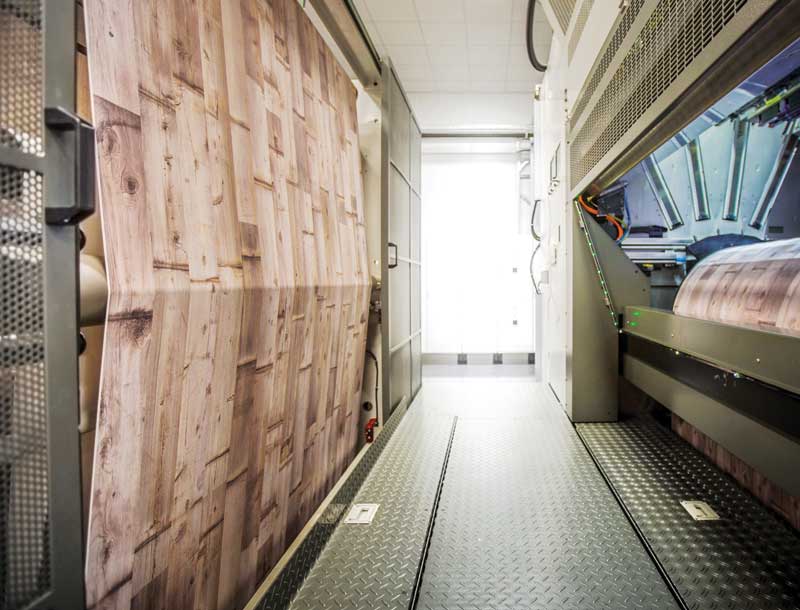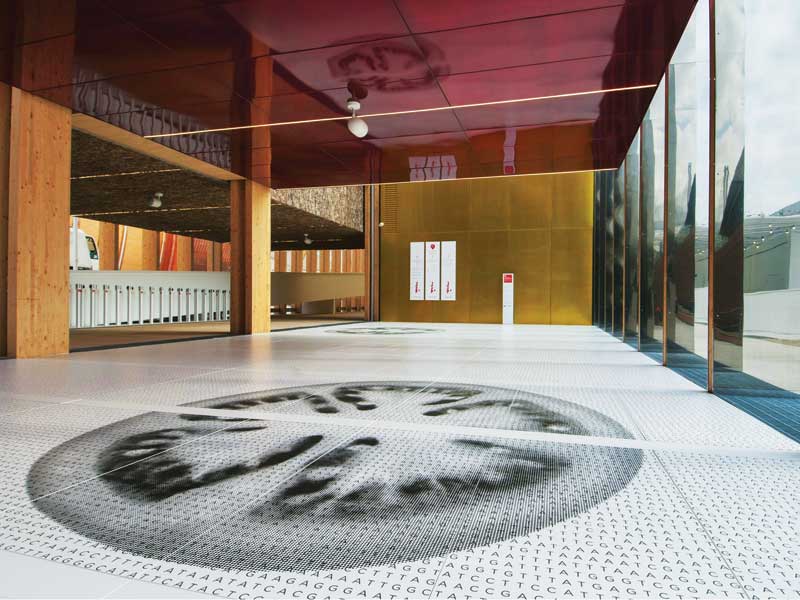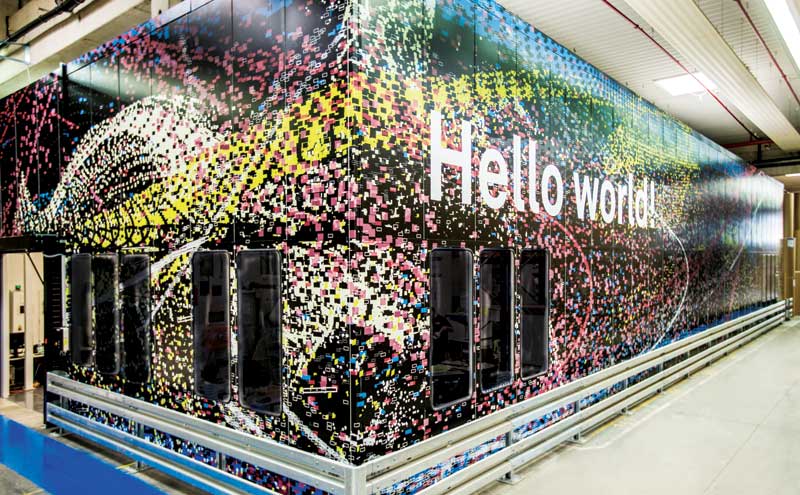Inkjet Printing: Patterns in decor production
by all | 27 March 2017 10:27 am
 [1]
[1]By Peter Saunders
The growing popularity of inkjet printing for textiles and ceramic tiles has been well-documented, but other interior decor applications are also now being handled digitally, including wood laminate flooring, ‘luxury’ vinyl tiles (LVTs) and wallcoverings. As inkjet printers change the decorative surfaces industry in the years to come, there will be both challenges and opportunities for sign shops.
“Decoration is a significant part of any industrial process, but particularly important when a product has to perform both a functional and an esthetic role,” says Marcus Timson, co-founder of the Industrial Print Show (InPrint), which recently conducted an industry survey in partnership with digital printing consultancy IT Strategies, decorative surfaces conference organizer TCM Conference Management and inkjet conference organizer IMI Europe. “We were seeing a growing consumer demand for mass customized products within the decor market, so we felt it was important to create a survey to investigate the rate of adoption further.”
The survey was conducted in July and August of 2016, with more than 100 participants within the decor production industry responding from around the world. The results suggest industrial printing is in a growth phase, with a market that is bullish about the potential for further inkjet printing of decor. As demand grows from the consumer market for shorter runs, more flexible production and customized finishing, industrial decor suppliers will be motivated to integrate inkjet technology to stay competitive. And an increasing importance is being placed on the esthetic and haptic (tactile) value of surface design.
Among the décor segments with the most potential for inkjet technology, 74 per cent of survey respondents cited wall surface applications, including wallpaper and images on glass, plastics and other materials, and 54 per cent highlighted flooring, including wood laminate and LVTs.
That said, even though single-pass inkjet systems have already virtually replaced their analogue predecessors in the ceramics sector, 75 per cent of respondents suggested digital technology will not replace analogue processes in the wider decor market, but rather add its own value and create new possibilities by performing roles and filling niches analogue cannot. Indeed, the survey found there is still a long way to go in convincing a traditional decor market that is heavily invested in analogue production to embrace inkjet systems.
 [2]
[2]Photo courtesy Gruppo Cosentino
Potential market growth
InPrint’s post-survey report suggests the rise of decor printing is linked to economic growth, the buoyancy of the global construction industry and demand for customized products. It is positioned to play a more significant role in the future, despite current problems that may be restricting adoption.
As mentioned, there appears to be strong potential for the inkjet printing of floorcoverings, moving on from its foundation with ceramic tiles to LVTs and wood laminate. Mark Hanley, president of IT Strategies, estimates the wholesale value of the global flooring market reached $240 billion U.S. in 2014, representing some 16 billion m2 (176 billion sf) of output. He points in particular to the Asia-Pacific (APAC) region, where new building construction and economic development, especially in China and India, are creating substantial demand for newly produced flooring.
“APAC markets accounted for 45 per cent of global demand in 2014 and will continue to represent more than 40 per cent as industrialization and rising incomes allow consumers to renovate,” says Hanley.
He also predicts the lower prices of LVTs and luxury vinyl planks (LVPs), compared to ceramic tiles, will begin to steal market share.
 [3]
[3]Photo courtesy Interprint
Investing in integration
Many of the respondents to InPrint’s survey (26 per cent) were industrial technology companies, including developers, integrators and manufacturers of printheads and inks.
“These digital suppliers have a lot of experience in what works and what doesn’t
in the decor market,” says Hanley. “They are ready to support new models.”
The rest of the survey’s participants were industrial production companies (19 per cent), material manufacturers (13 per cent), retailers (five per cent), designers (three per cent) and ‘others’ (34 per cent).
For these companies, integrating inkjet technology into the production of floorcoverings and wallcoverings will take significant time and investment, but they are optimistic about the results. Nearly 25 per cent of them predicted inkjet-printed decor will experience a growth rate of up to five per cent, more than 38 per cent forecast a rate of between 10 and 15 per cent and, finally, more than 36 per cent supported a rate of 15 per cent or more.
“Growth rates only normalize when the market reaches a threshold volume, which on the whole it has not done yet,” says Hanley. “Rates will be higher before and lower later.”
Walls vs. floors
When comparing walls to floors, customization is more easily achievable for wallcoverings, as they do not face the same functional challenges of toughness and durability and, for that matter, their costs per area are lower. Further, inkjet printing of wallpaper has been possible for many shops for several years now. So, wallcoverings have seemingly represented stronger potential for inkjet than flooring.
“Wallpaper’s popularity reflects publicity around technologies like durable aqueous ‘latex’ inks, as well as successful retail applications,” says Hanley.
Nonetheless, the potential for inkjet-printed flooring and laminates was regarded as significant by the respondents to InPrint’s survey. The technical challenges, supply chain complexity and production demands are greater, but so is the overall scale of the market. Once inkjet technology starts to make inroads, the data suggests, the volume of flooring it handles could easily outpace wallpaper production in the medium term, particularly as floorcovering suppliers recognize its value in reducing multiple stages of production, enhancing efficiency and accelerating the speed of bringing new products to market.
Short-run vs. industrial-capacity
InPrint’s research also suggests there are, broadly, two types of markets for inkjet printing of decor: (a) a short-run industrial market, served by existing flatbed and roll-to-roll (RTR) inkjet printers, and (b) an industrial-capacity market focused on customized, single-pass, in-line inkjet production, including direct-to-surface printing.
The survey suggests the short-run market has the strongest potential as a key opportunity. The individualized, frequently changeable environments that are achievable with digital inkjet printing tend to require localized production and are less likely to be part of a mass production line. The customer base includes commercial, retail and hospitality venues, including restaurants and hotels.
There is also a considerable amount of investment in direct-to-surface inkjet printing. In flooring, this technology provides a high-quality, lower-cost alternative to other decoration methods, e.g. by simulating both the esthetic and haptic traits of wood. If the ‘feel’ of the print matches its visual appearance, the perceived value is higher. With such specialized applications, however, this higher value is countered by smaller market potential.
“Direct-to-surface haptic inkjet printing is still in early phases of development,” says Hanley. “It can work as a substitute for expensive wood and will probably get bigger over time.”
That said, inkjet printing of laminates for flooring is also helpful for shorter runs. The technology offers flexibility that may appeal even to larger manufacturers.
 [4]
[4]Photos courtesy Formica Group
Benefits and obstacles
The survey’s participants were asked, “What do you believe is the main value that inkjet printing provides for decor production?” With multiple answers permitted, the most popular options cited were the following:
- The ability to print short runs, due to the flexibility in production and cost savings (85.3 per cent).
- The ability to personalize and customize output (72.6 per cent).
- The freedom for designers to experiment and add new value (64.7 per cent).
- The ability to print multiple designs without increasing costs (52.9 per cent).
- Savings from not having to stock large inventories (48 per cent).
- The ability to print direct-to-surface without paper (35.3 per cent).
- Savings from consolidating and/or simplifying the supply chain (32.4 per cent).
“These responses seem to be more typical of a consumer-oriented market than an industrial one,” says Hanley. “It is more creative, but it is also harder to build from scratch.”
With that in mind, participants were also asked which problems are holding back inkjet adoption in the decor industry. The following were the top answers cited:
- A lack of technology knowledge and expertise among potential users (59. 6 per cent).
- High costs of ink (56.6 per cent).
- Technical difficulties with non-contact inkjet printing onto challenging surfaces (47.5 per cent).
- Prevention of change by companies threatened by potential disruption (30 per cent).
- Lack of open collaboration between suppliers (26.3 per cent).
- Misleading assumptions about digital technology needing to be simple to implement (26.3 per cent).
- Heavy investments in older technology making change seem too risky (25.3 per cent).
- Limited selection of digital print machinery options (20.2 per cent).
“The concerns about high costs and lack of knowledge are not really correct, but default answers until the industry decides the time is right,” says Hanley.
InPrint, for its part, responds to these concerns by emphasizing the need for more effective collaboration between inkjet technology manufacturers, particularly given the steeper learning curves, longer-term investments and yet-unclear value propositions faced by large-scale floorcovering producers. Also, data suggests ink costs will be high until the market develops and matures, at which point they will decrease and normalize.
Changes to come
Finally, survey participants were asked what changes would be needed for inkjet printing to become more widely used for decor. With multiple answers again permitted, the most popular options were as follow:
- Improved understanding of inkjet’s value as an additional technology, rather than a replacement (62.4 per cent).
- Greater knowledge of the flexibility inkjet technology offers to designers (57.4 per cent).
- More collaboration between suppliers of industrial inkjet equipment, inks, integration and expertise (55.5 per cent).
- Access to lower-cost inks (39.6 per cent).
- Clearer rationale to justify changing and adopting inkjet printing (27.7 per cent).
- More openness from the flooring industry to accepting new technology (23.8 per cent).
Certainly, it is difficult to convince business owners to take a risk on new technology when there is hardly any proof yet of it being used successfully by key companies in the same market.
“The existing scaled decor market has so far failed to get into digital printing for a range of reasons,” says Hanley. “This will change, but the day has not yet come. For now, direct-to-consumer is a better bet.”
As when any new production technology enters a given market, InPrint explains, there will be an initial period of resistance and learning until further clarity is gained as to the specific role it will play and the relevance it will have in the long term. InPrint also points out are projects set to launch that will help show what specific value inkjet technology can add to floorcoverings and wallcoverings. Once these competitive advantages are proven, the rest of the market will begin to integrate inkjet technology, too.
There is already a high level of interest and a confident expectation of growth. The next few years should be significant for industrial inkjet printing of decor.
With files from InPrint, the next edition of which will be held from Apr. 25 to 27, 2017, at the Orange County Convention Center in Orlando, Fla. For more information, visit www.inprintshow.com[5].
- [Image]: https://www.signmedia.ca/wp-content/uploads/2017/03/inkjet_6_IP_DigitalPrintingMachine_No-4_3508.jpg
- [Image]: https://www.signmedia.ca/wp-content/uploads/2017/03/inkjet_tomato.jpg
- [Image]: https://www.signmedia.ca/wp-content/uploads/2017/03/inkjet_helloworld.jpg
- [Image]: https://www.signmedia.ca/wp-content/uploads/2017/03/Featured1.jpg
- www.inprintshow.com: http://www.inprintshow.com
Source URL: https://www.signmedia.ca/inkjet-printing-patterns-in-decor-production/